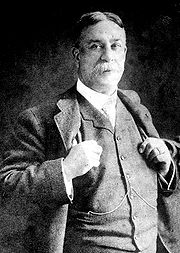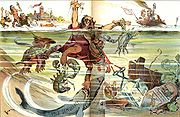
Eugene Zimmerman
Encyclopedia

Cartoonist
A cartoonist is a person who specializes in drawing cartoons. This work is usually humorous, mainly created for entertainment, political commentary or advertising...
, was born on May 23, 1862 and died on March 26, 1935. Known by his famous signature "Zim", he was born in Basel
Basel
Basel or Basle In the national languages of Switzerland the city is also known as Bâle , Basilea and Basilea is Switzerland's third most populous city with about 166,000 inhabitants. Located where the Swiss, French and German borders meet, Basel also has suburbs in France and Germany...
, Switzerland
Switzerland
Switzerland name of one of the Swiss cantons. ; ; ; or ), in its full name the Swiss Confederation , is a federal republic consisting of 26 cantons, with Bern as the seat of the federal authorities. The country is situated in Western Europe,Or Central Europe depending on the definition....
. He lost his mother and was sent to live with relatives in Alsace. In 1867 his father, who was a baker, and an older brother emigrated to the United States. Two years later Zimmerman was placed on a ship and followed them.
Poverty and restricted circumstances characterized his early years as he moved from relatives to working in different jobs. In 1877 he became an apprentice sign painter and continued in this line of work for several years, nurturing a desire to become a professional cartoonist. By copying the work of cartoonists, he acquired the skills necessary to gather a portfolio, which gained him an interview in May of 1883 with Joseph Keppler, the director of Puck Magazine. He was hired and began work at one of the most remarkable satirical magazines of the late 19th century. While he worked at Puck, he supplemented his income with lucrative freelance work. In 1885 he dropped the last portion of his signature and became known as Zim.
After two and a half years at Puck (from May 1883 to December 1885), Zim moved to Judge magazine directed by Bernhard Gillam. Here he was better paid and enjoyed greater freedom in his selection of subjects. The following year he married Mabel Alice Beard of Horseheads, New York
Horseheads (village), New York
Horseheads is a village in Chemung County, New York, USA. The population was 6,461 at the 2010 census. The name is derived from the number of bleached skulls of pack horses left behind by the Sullivan Expedition....
. In 1888, in search of a more gentle pace of life, he and Mabel moved to Horseheads. Zim then traveled to New York on alternate weeks to fulfill his commitments at the magazine. Like many contemporary cartoonists, Zim generated cartoons of all varieties, including some which could be considered offensive for their ethnic stereotypes. He remained at Judge until his retirement in 1912.
Becoming one of America's best known cartoonists, he printed more than 40,000 sketches in his lifetime. The illustrious painter William Merritt Chase
William Merritt Chase
William Merritt Chase was an American painter known as an exponent of Impressionism and as a teacher. He is also responsible for establishing the Chase School, which later would become Parsons The New School for Design.- Early life and training :He was born in Williamsburg , Indiana, to the family...
, on a visit to the offices of Judge in 1897, voiced his praise for Zim's artistry and related that the artist Edwin Austin Abbey
Edwin Austin Abbey
Edwin Austin Abbey was an American artist, illustrator, and painter. He flourished at the beginning of what is now referred to as the "golden age" of illustration, and is best known for his drawings and paintings of Shakespearean and Victorian subjects, as well as for his painting of Edward VII's...
pasted his work in a book.
After his retirement from Judge, Zim was founder and first president of the American Association of Cartoonists and Caricaturists.
In Horseheads, Zim participated actively in the life of the community. He eventually designed the small town's Teal Park
Teal Park
Teal Park is a public greenspace is Horseheads, New York. The land for the park was donated to the town in 1807. In 1910, political cartoonist Eugene Zimmerman, a resident of the town, designed the bandstand still standing today, known as the Zim bandstand....
Bandstand.
Horseheads preserves the artist's residence, known as Zim House
Zimmerman House (Horseheads, New York)
Zimmerman House, also known as Zim House, is a historical structure located in Horseheads, New York. It was the home of cartoonist Eugene Zimmerman, also known as "Zim". The architectural and historic significance of the house led to its listing in the National Register of Historic Places in...
, that possesses papers, sketches, and correspondence.
The best guide to the life of Zim is the text by Walter Brasch, which edits an autobiography and publishes an essential bibliography.
Works

- This and That About Caricature. New York: Syndicate Press, 1905.
- Cartoons and Caricatures. Scranton, PA: Correspondence Institute of America, 1910.
- ZIM's Foolish History of Elmira and its Tributaries. Horseheads, NY: Chemung Valley Reporter, 1911.
- ZIM's Foolish History of Horseheads. Horseheads, NY: Eugene Zimmerman, 1911.
- In Dairyland. Horseheads, NY: Eugene Zimmerman, 1914.
- Language and Etticket of Poker. Horseheads, NY: Eugene Zimmerman, 1916.
- A Jug Full of Wisdom; Homespun Phoolosophy. Horseheads, NY: Eugene Zimmerman, 1916.
- Fire; Heroic Deeds for the Dingville Fire Department. Buffalo, NY: Holling Press, 1922.
- Foolish History of Horseheads. Horseheads, NY: Chemung Valley Reporter, 1927.
- Foolish History of Horseheads. Horseheads, NY: Eugene Zimmerman, 1929.

